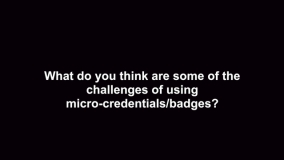Learn more about our new EU project on micro credentials: MicroHE (official EU Info) and read my earlier BlogPost about it.
 This is an important topic of future higher education. Microcredentials, also envisioned as bite-sized degrees are gaining traction. In 2015, The Brookings Institute released a paper proporting that abbreviated online degree programs are upending education and giving traditional programs competition. This is particularly true in the tech sector, where skills-based certifications already have a long track record. In todays world, students throughout their lifetime are educated, learning, studying lifelong with a multitude of different providers, in different contexts and occasions, purposes and outcomes, informally and formally. To use these learning experiences and try to combine them, to make them usable and understandable is the next step and high art of higher education development. By providing common language and a unified framework for understanding the competencies associated with different credentials, applications of the Framework can improve all of the following:
This is an important topic of future higher education. Microcredentials, also envisioned as bite-sized degrees are gaining traction. In 2015, The Brookings Institute released a paper proporting that abbreviated online degree programs are upending education and giving traditional programs competition. This is particularly true in the tech sector, where skills-based certifications already have a long track record. In todays world, students throughout their lifetime are educated, learning, studying lifelong with a multitude of different providers, in different contexts and occasions, purposes and outcomes, informally and formally. To use these learning experiences and try to combine them, to make them usable and understandable is the next step and high art of higher education development. By providing common language and a unified framework for understanding the competencies associated with different credentials, applications of the Framework can improve all of the following:
- Equity. More transparent credentials create clearly visible pathways to increase career and economic mobility for historically underserved and underrepresented populations.
- Credential Transparency. A framework makes it easier to understand the competencies associated with any credential.
- Comparability. It makes it possible for stakeholders to compare the value of various credentials and determine which credential best fits their needs.
- Portability. It supports the translation of learning acquired across institutions and between academic institutions and employers.
The Background
 Today’s marketplace for postsecondary education credentials is highly fragmented, ranging from badges and industry-based certifications to two- and four-year degrees and beyond. It’s a complex, multi-layered ecosystem that presents major challenges for students, employers, workers and policymakers. Individuals encounter too many dead ends as they work to gain the skills and credentials they need to advance. Employers have lost trust in some credentials as they seek the skilled employees they need to compete globally. Policymakers at all levels are unsure about how to assure quality education and credentials in an increasingly diversi ed learning environment. Over the past 30 years, there’s been an increase of more than 800 percent in the number of certificates awarded by higher education institutions and other providers of education and training. At the same time, the number of certifications offered by industry-based organizations has grown extensively. The immense growth of online learning and the development of new kinds of credentials such as badges compound the problem further. Validation of credentials is uneven, too. In short, the credentialing world is confusing, at times even chaotic. To enhance the utility of credentials and reduce the costs borne by individuals and employers, we need a common language – a homogenized analytic framework that helps stakeholders compare the value and suitability of different types of credentials.
Today’s marketplace for postsecondary education credentials is highly fragmented, ranging from badges and industry-based certifications to two- and four-year degrees and beyond. It’s a complex, multi-layered ecosystem that presents major challenges for students, employers, workers and policymakers. Individuals encounter too many dead ends as they work to gain the skills and credentials they need to advance. Employers have lost trust in some credentials as they seek the skilled employees they need to compete globally. Policymakers at all levels are unsure about how to assure quality education and credentials in an increasingly diversi ed learning environment. Over the past 30 years, there’s been an increase of more than 800 percent in the number of certificates awarded by higher education institutions and other providers of education and training. At the same time, the number of certifications offered by industry-based organizations has grown extensively. The immense growth of online learning and the development of new kinds of credentials such as badges compound the problem further. Validation of credentials is uneven, too. In short, the credentialing world is confusing, at times even chaotic. To enhance the utility of credentials and reduce the costs borne by individuals and employers, we need a common language – a homogenized analytic framework that helps stakeholders compare the value and suitability of different types of credentials.
 Such a framework would need to use competencies – what the learner knows and is able to do – as common reference points to help understand and compare the levels and types of knowledge and skills that underlie degrees, certificates, industry certifications, licenses, apprenticeships, badges and other credentials. Competencies are understood both in industry and academia and can be applied in multiple contexts, making them a powerful way to examine credentials.
Such a framework would need to use competencies – what the learner knows and is able to do – as common reference points to help understand and compare the levels and types of knowledge and skills that underlie degrees, certificates, industry certifications, licenses, apprenticeships, badges and other credentials. Competencies are understood both in industry and academia and can be applied in multiple contexts, making them a powerful way to examine credentials.
A very interesting US platform (run by the Lumina Foundation from Indianapolis) which is working with more than 120 certification agencies together is called ConnectingCredentials (find it here). The platform uses a framework which allows to break down credentials into comparable 8 level of competences, skills and knowledge (find it here).
Learn more about our new EU project on micro credentials: MicroHE (official EU Info) and read my earlier BlogPost about it.

Pingback: Future higher education by ‘Futurelearn’ | Ulf-Daniel Ehlers